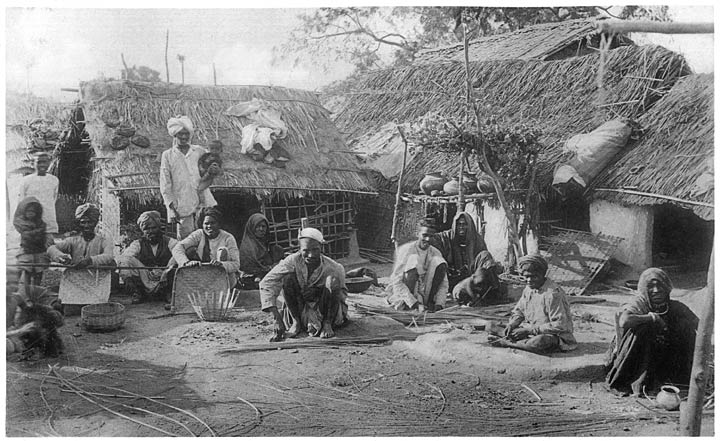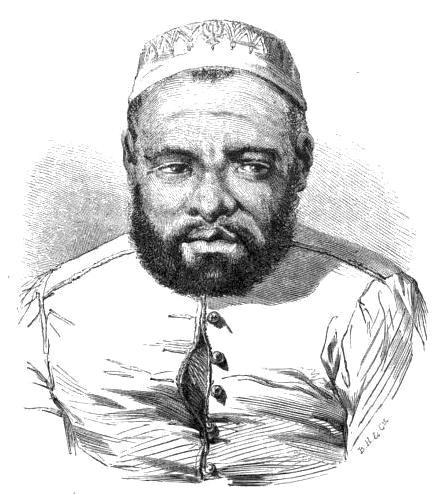|
Hova (Madagascar)
The Hova, or free commoners, were one of the three principal historical castes in the Merina Kingdom of Madagascar, alongside the Andriana (nobles) and Andevo (slaves). The term ''hova'' originally applied to all members of a Malagasy clan (possibly of the Zafiraminia people) that migrated into the central highlands from the southeast coast of the island around the 15th century and absorbed the existing population of Vazimba. Andriamanelo (1540–1575) consolidated the power of the Hova when he united many of the Hova chiefdoms around Antananarivo under his rule. The term Hova remained in use through the 20th century, though some foreigners transliterated that word to be ''Ankova'', and increasingly used since the 19th century. In and after the 16th century, slaves were brought into Madagascar's various kingdoms, and social strata emerged in Merina kingdom. The Hova emerged as the free commoners caste below the nobles hierarchy. The subset of Hova related to the king by blood came ... [...More Info...] [...Related Items...] OR: [Wikipedia] [Google] [Baidu] |
Caste
A caste is a Essentialism, fixed social group into which an individual is born within a particular system of social stratification: a caste system. Within such a system, individuals are expected to marry exclusively within the same caste (endogamy), follow lifestyles often linked to a particular occupation, hold a ritual status observed within a hierarchy, and interact with others based on cultural notions of social exclusion, exclusion, with certain castes considered as either more pure or more polluted than others. The term "caste" is also applied to morphological groupings in eusocial insects such as ants, bees, and termites#caste, termites. The paradigmatic ethnographic example of caste is the division of India's Hinduism, Hindu society into rigid social groups. Its roots lie in South Asia's ancient history and it still exists; however, the economic significance of the caste system in India seems to be declining as a result of urbanisation and affirmative action programs. ... [...More Info...] [...Related Items...] OR: [Wikipedia] [Google] [Baidu] |
Merina Kingdom
The Kingdom of Merina, also known as the Kingdom of Madagascar and officially the Kingdom of Imerina (; –1897), was a pre-colonial state off the coast of Southeast Africa that, by the 18th century, dominated most of what is now Madagascar. It spread outward from Imerina, the Central Highlands region primarily inhabited by the Merina ethnic group with a spiritual capital at Ambohimanga and a political capital west at Antananarivo, currently the seat of government for the modern state of Madagascar. The Merina kings and queens who ruled over greater Madagascar in the 19th century were the descendants of a long line of hereditary Merina royalty originating with Andriamanelo, who is traditionally credited with founding Imerina in 1540. In 1883, France invaded the Merina Kingdom to establish a protectorate. France invaded again in 1894 and conquered the kingdom, making it a French colony, in what became known as the Franco-Hova Wars. History Hova-Vazimba conflict Mad ... [...More Info...] [...Related Items...] OR: [Wikipedia] [Google] [Baidu] |
Madagascar
Madagascar, officially the Republic of Madagascar, is an island country that includes the island of Madagascar and numerous smaller peripheral islands. Lying off the southeastern coast of Africa, it is the world's List of islands by area, fourth largest island, the List of island countries, second-largest island country, and the List of countries and dependencies by area, 46th largest country overall. Its capital and List of cities in Madagascar, largest city is Antananarivo. Following the prehistoric breakup of the supercontinent Gondwana, Madagascar split from Africa during the Early Jurassic period, around 180 million years ago, and separated from the Indian subcontinent approximately 90 million years ago. This isolation allowed native plants and animals to evolve in relative seclusion; as a result, Madagascar is a biodiversity hotspot and one of the world's 17 megadiverse countries, with over 90% of its wildlife of Madagascar, wildlife being endemic. The island has ... [...More Info...] [...Related Items...] OR: [Wikipedia] [Google] [Baidu] |
Andriana
Andriana was both the noble class and a title of nobility in Madagascar. Historically, many Malagasy ethnic groups lived in highly stratified caste-based social orders in which the Andriana were the highest strata. They were above the Hova (free commoner castes) and Andevo (slaves). The Andriana and the Hova were a part of ''Fotsy'', while the Andevo were ''Mainty'' in local terminology. The Andriana strata originally constituted the Merina society's nobility, warrior, and land-owning class. They were endogamous, and their privileges were institutionally preserved. While the term and concept of ''Andriana'' is associated with the Merina people of Madagascar, the term is not limited to them. The use of the word "Andriana" to denote nobility occurs among numerous other Malagasy ethnic groups such as the Betsileo, the Betsimisaraka, the Tsimihety, the Bezanozano, the Antambahoaka, and the Antemoro. "Andriana" often traditionally formed part of the names of Malagasy kings, prin ... [...More Info...] [...Related Items...] OR: [Wikipedia] [Google] [Baidu] |
Andevo
The Andevo, or slaves, were one of the three principal historical castes among the Merina people of Madagascar, alongside the social strata called the Andriana (nobles) and Hova (free commoners). The Andevo, along with the other social strata, have also historically existed in other large Malagasy ethnic groups such as the Betsileo people. In and after the 16th century, slaves were brought into Madagascar's various kingdoms to work in plantations. The Malagasy, the Swahili, and the European merchants and nobles expanded their opportunities to produce more and trade. These operations and plantations were worked by the forced labor of imported slaves. The largest influx of slaves was brought in by the 'Umani Arabs via the Indian Ocean slave trade and the French. The Mozambique were one of the major victims of this demand, slave capture and export that attempted to satisfy this demand. These slaves were predominantly from East Africa and Mozambique. These slaves were called Andevo. ... [...More Info...] [...Related Items...] OR: [Wikipedia] [Google] [Baidu] |
Vazimba
The Vazimba (Malagasy ), according to popular belief, were the first inhabitants of Madagascar. While beliefs about the physical appearance of the Vazimba reflect regional variation, they are generally described as smaller in stature than the average person, leading some scientists to speculate that they may have been a pygmy people (and therefore a separate ethnic groups of Madagascar, Malagasy ethnic group) who migrated from the islands that constitute modern-day Indonesia and settled in Madagascar over the course of the period between 350 BCE–500 CE. Scientific evidence confirms the first arrival and subsequent increase of human settlers on the island during this period, but the pygmy theory has not been proven. Stories about the Vazimba form a significant element in the cultural history and collective identity of the Malagasy people, ranging from the historical to the supernatural, inspiring diverse beliefs and practices across the island. They have analogs in some other ... [...More Info...] [...Related Items...] OR: [Wikipedia] [Google] [Baidu] |
Andriamanelo
Andriamanelo (Floruit, ''fl.'' 1540–1575) was king of Twelve sacred hills of Imerina#Hill of Alasora, Alasora in the central highlands region of Madagascar. He is generally considered by historians to be the founder of the Kingdom of Imerina and originator of the Merina royal line that, by the 19th century, had extended its rule over virtually all of Madagascar. The son of a Vazimba mother and a man of the newly arrived Hova (Madagascar), Hova people originating in Anosy, southeast Madagascar, Andriamanelo ultimately led a series of military campaigns against the Vazimba, beginning a several-decade process to drive them from the Highlands. The conflict that defined his reign also produced many lasting innovations, including the development of fortified villages in the highlands and the use of iron weapons. Oral tradition furthermore credits Andriamanelo with establishing a ruling class of nobles (''andriana'') and defining the rules of succession. Numerous cultural tradition ... [...More Info...] [...Related Items...] OR: [Wikipedia] [Google] [Baidu] |
Antananarivo
Antananarivo (Malagasy language, Malagasy: ; French language, French: ''Tananarive'', ), also known by its colonial shorthand form Tana (), is the Capital city, capital and largest city of Madagascar. The administrative area of the city, known as Antananarivo-Renivohitra ("Antananarivo-Mother Hill" or "Antananarivo-Capital"), is the capital of Analamanga region. The city sits at above sea level in the center of the island, making it the List of capital cities by elevation, highest national capital by elevation among the Island country, island countries. It has been the country's largest population center since at least the 18th century. The President of Madagascar, Presidency, National Assembly of Madagascar, National Assembly, Senate of Madagascar, Senate, and Supreme Court are located there, as are List of diplomatic missions in Madagascar, 21 diplomatic missions and the headquarters of many national and international businesses and Non-governmental organization, non-governme ... [...More Info...] [...Related Items...] OR: [Wikipedia] [Google] [Baidu] |
En Trevlig Hovagosse, Kotokeli, Sluszanskis Fosterson
EN or En or en may refer to: Businesses * Bouygues (stock symbol EN) * Island Rail Corridor, formerly known as the Esquimalt and Nanaimo Railway (reporting mark EN) * Euronews, a news television and internet channel Language and writing * N, 14th letter of the Roman alphabet * EN, a mark in Sumerian cuneiform script for a High priest or Priestess (meaning "lord", or "priest") *En (digraph) /‹en›/, a phoneme *En (Cyrillic), 15th letter of the Cyrillic alphabet *En (typography), a unit of typographical width ** Dash#En dash /en dash/, a dash of length 1 en *En language, a language spoken in northern Vietnam *English language (ISO language code: en) Organisations * Eastern National, a US organization providing educational products to National Park visitors * English Nature, a former UK government conservation agency * Envirolink Northwest, an environmental organization in England Religion * En (deity) in Albanian mythology Science and technology * Engineer * E''n'' (Lie al ... [...More Info...] [...Related Items...] OR: [Wikipedia] [Google] [Baidu] |
Ralambo
Ralambo was the ruler of the Kingdom of Imerina in the central Highlands region of Madagascar from 1575 to 1612. Ruling from Ambohidrabiby, Ralambo expanded the realm of his father, Andriamanelo, and was the first to assign the name of Imerina to the region. Oral history has preserved numerous legends about this king, including several dramatic military victories, contributing to his heroic and near-mythical status among the kings of ancient Imerina. The circumstances surrounding his birth, which occurred on the highly auspicious date of the first of the year, are said to be supernatural in nature and further add to the mystique of this sovereign. Oral history attributes numerous significant and lasting political and cultural innovations to King Ralambo. He is credited with popularizing the consumption of beef in the Kingdom of Imerina and celebrating this discovery with the establishment of the '' fandroana'' New Year's festival which traditionally took place on the day of Ral ... [...More Info...] [...Related Items...] OR: [Wikipedia] [Google] [Baidu] |
Merina People
The Merina people (also known as the Imerina, Antimerina, Borizany or Ambaniandro) formerly called Amboalambo are the largest ethnic group in Madagascar.Merina people Ethnic Groups of Madagascar Encyclopædia Britannica They are the "highlander" Malagasy ethnic group of the African island and one of the country's eighteen official ethnic groups. Their origins are mixed, predominantly with [...More Info...] [...Related Items...] OR: [Wikipedia] [Google] [Baidu] |






